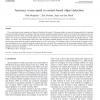Free Online Productivity Tools
i2Speak
i2Symbol
i2OCR
iTex2Img
iWeb2Print
iWeb2Shot
i2Type
iPdf2Split
iPdf2Merge
i2Bopomofo
i2Arabic
i2Style
i2Image
i2PDF
iLatex2Rtf
Sci2ools
111
Voted
PRL
2007
2007
Accuracy versus speed in context-based object detection
The visual detection and recognition of objects is facilitated by context. This paper studies two types of learning methods for realizing context-based object detection in paintings. The first method is called the gradient method; it learns to transform the spatial context into a gradient towards the object. The second method, the context-detection method, learns to detect image regions that are likely to contain objects. The accuracy and speed of both methods are evaluated on a face-detection task involving natural and painted faces in a wide variety of contexts. The experimental results show that the gradient method enhances accuracy at the cost of computational speed, whereas the context-detection method optimises speed at the cost of accuracy. The different results of both methods are argued to arise from the different ways in which the methods trade-off accuracy and speed. We conclude that both the gradient method and the contextdetection method can be applied to reliable and...
Related Content
| Added | 27 Dec 2010 |
| Updated | 27 Dec 2010 |
| Type | Journal |
| Year | 2007 |
| Where | PRL |
| Authors | Niek Bergboer, Eric O. Postma, H. Jaap van den Herik |
Comments (0)

